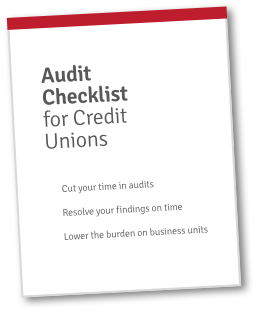Are your credit union audit findings always resolved reliably and on time? Have you ever found inconsistencies or outliers? Have you dealt with repeat findings?
Recently, we discussed the role of structure in credit union audit programs. We suggested that structure is key to resolving findings on time—and keeping them consistent. But structure is just one of three key components to reliably resolving findings.
Unfortunately, a common bottleneck in the audit process are the business units involved. Audits are not their primary job—and audit activity does not top their priority list. And, because audits can be tedious, getting buy-in can be difficult.
That’s not to say that business units are hard to work with. Quite the contrary! They are generally fantastic team players. But when you ask them to drop what they’re doing to help out, you’ll need to make it easy on them.
Three Ways to Accommodate Business Departments and Leaders
In our Findings Accountability Framework, we list business units as a foundational part of successful, repeatable audits. When you involve other credit union departments in your audit process, they may need a bit of handholding.
Generally, business units want to help. But they have their own duties to deal with, and they don’t have time to search through your spreadsheets to figure out what they need to do. If the process isn’t quick and simple, they will get frustrated. Maybe they’ll put things off for a day. Or two. Or five.
Here are three ways you can support other departments and leaders through your audit process:
1. Change your mindset
The first thing to change should be the way you think about your engagements with business departments. They’re collaborators who need guidance. And your effort will be mutually beneficial. If you make it easy for them to complete their tasks, they’ll reward you with completed tasks!
Be proactive about giving business units everything they need to be successful. That could be guidance or deadlines, setting reminders, or simply taking the initiative.
Find out what they need and give it to them.
2. Tailored to-do lists
Every person involved should have their own to-do list. And that means a personalized to-do list. Credit union audits have a lot of moving parts, and business units can’t keep track of them all. Show them exactly what they need to do and by when. It’ll simplify things for them, and they’ll be less likely to get overwhelmed or frustrated.
Don’t keep all to-dos in a general document! If someone has to scour through a shared document to find their tasks, they may get lost in the noise.
Also, for department leaders, we recommend keeping two lists. One list should show everything that’s assigned to them. The second list should show everything they’re accountable for. It should show what’s been assigned to their team so that they can manage their team.
3. Centralization and organization
Keep everything in one place. Nobody should have to search all over the place for documents. It’s just not user-friendly or intuitive!
This centralized repository should hold requests, reports, spreadsheets, documents, etc.
Free Webinar
Final Thoughts About Involving Business Departments
Often, the audit team has things handled… but the business teams don’t. Unfortunately, that makes it hard to scale the program. Individualized to-do lists ensure that all parties know what needs to be done, how, and by when. And if all these documents are centralized, your business units will thank you.
But there’s more to it all. Join us for our next Findings Accountability Framework webinar. We’ll cover this topic in detail, plus we’ll dig into the other critical components of a successful audit program.


 Get FREE Access to the Audit Checklist for Credit Unions!
Get FREE Access to the Audit Checklist for Credit Unions!


